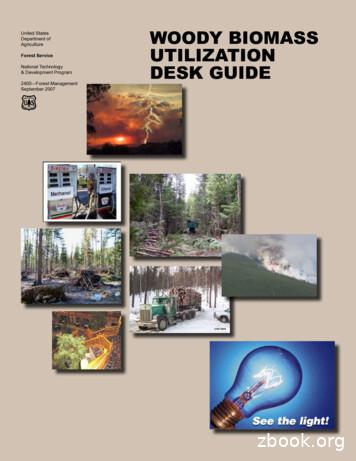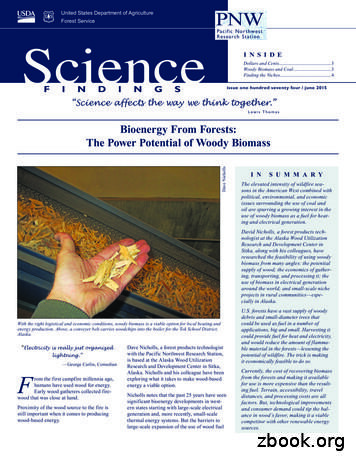Woody Biomass Feedstock Supply Potential In NY State
Woody Biomass Feedstock SupplyPotential in NY StateT.A. Volk1, P. Woodbury2, P. Castellano1, R. Germain1, T. Buchholz11SUNY-ESF, 2Cornell UniversityWoody Biomass Energy Research Symposium for the NorthernForestApril 28-29, 2011, Burlington, VT
Renewable Fuels Roadmap Funders
Overview Energy Use in the U.S.Woody BiomassNY Renewable Fuels RoadmapWoody Biomass from ForestsPotential Biomass Supply in NYBioproducts from Woody Biomass
History of U.S. Energy Use
Wood Used for Energy in the U.S.(Bain and Overend, 2002)The chemical wood industry in southern NY andPennsylvania was a major forest industry in the late 1800sand early 1900s
U.S. EnergySources We use almost 100 quads of energy in theU.S. each year- This is 22.5% of theworld’s primaryenergy consumption- But we are only4.6% of the world’spopulationWood is the secondlargest source ofrenewable energy(EIA 2010)
NY Renewable Fuels Roadmap Feedstock assessment State of conversion technologyPotential biofuels productionin NYPotential environmental andeconomic impactsAssessment of policies relatedto the development of abiofuels industry
NY’S Abundant Resource Base Potential sources ofbiomass for biofuels:– Perennial energy crops» Cool or warm season grasses» Short rotation woody cropslike shrub willowLand cover in NYS (Woodbury et al. 2009)– Woody biomass from forestsincluding low value materialand residues– A portion of crop residuessuch as corn stover– Waste streams such as greasefor biodiesel
Perennial EnergyCrops in NYHarvesting three year oldwillow biomass cropsSwitchgrass trial – courtesy ofH. Mayton, Cornell University
NY’s Forest Resources 18.5 million acres Forest land is the dominates land cover in NYof forest land15.4 million acresof timberland774 million tons ofstanding biomasson timberlandSteep decline inpulp and paperoperations in NY inthe past 25 yearsfrom over 15 to 2operations today.
Determining Forest BiomassAvailability Two step process:1. Calculate technically available biomass – the amountof biomass that is available and accessible on theground and within certain defined limits» Used FIA and TPO data from 2002 - 2007on a county bycounty scale2. Estimate the amount of biomass that might beharvested» Used a sustainable yield management model (Vickery et al.2009) based on road density for each of the 950 townshipsin NY
Limitations on Forest Biomass Restrictions applied during forest biomassassessments:– prohibited harvesting in the forest preserve and otherprotected areas– limited the size of the harvest of traditional forest productsand additional biomass for biofuels based on the netannual growth rate of forests in each county– restricted the proportion of tops and residues collectedand prohibited the collection of mortality to addressconcerns related to nutrient depletion and biodiversity– used a sustainable yield model to address concernsrelated to site conditions, future demographics, or potentialdevelopment that might impact long term sustained yieldmanagement
Net annual growth of growingstock based on 2002-2006FIA dataTotal 9.6 million odt
Technically Available MerchantableBiomass¾ Available Biomass 0.70 * Net AnnualGrowth - Current Removals¾Calculated for each county¾Did not include additional tops and harvestresidues associated with the increasedharvesting for bioenergy
Net annual growth of growingstock minus removalsTotal 5.1 million odt46% Reduction The Research Foundation of SUNY 2007
Non Commercial Species Determined biomass of non commercialspecies by county Removed small diameter material 5” Assumed 3% of the biomass could berecovered each year Provides 2.9 million odt/yr
Recoverable Material Assume that 65% of logging residuescan be recovered from currentharvesting operations Adds another 0.91 million odt/yr Logging residues makes up 90% ofrecoverable material in all counties Additional biomass is from landclearing/conversion
Technically Available Woody Biomass 9.0 million odt/yr oftechnically availablewoody biomass– 75% hardwoods– Majority (57.4%) frommerchantable categoryfollowed by noncommercial (32.4%)categoryTechnically available woody biomass fromtimberland in each county in NY (Woodburyet al. 2010) Equates to 0.6odt/acre of timberland
Socio-economic Potential Amount of technically available resource will varydue to a range of socioeconomic factors:– Market prices for other energy sources (coal, oil,natural gas)– Prices for biomass for other uses (i.e. pulp logs, sawlogs, mulch)– Landowners opinions and management objectives– Competition from other biomass users– Incentives and policies that support renewable energy– Pubic opinions about biomass resources and their use
Sustainable Yield Management Applied a SYM modelN u m b er o f C o u n ties121086 4200-910-1920-2930-3940-4950-5960-6970-7980-89 90-100Percent Sustainable Yield Management Based on Road DensityDistribution of counties based on predictedsustainable yield management potential using themodel developed by Vickery et al. (2009). (Vickery et al. 2009) basedon road density for 983townships in NYCalculated county meansbased on a township landarea weighted averageAcross the state potentialfor SYM occurs on 49% ofthe land areaReduced potential availablebiomass by 46%
(based on model developed by Vickery et al. 2009,modified for forest preserve land)Sustainable Yield Management Model
Potentially Available Biomass 4.8 million odt/yravailable – 54% oftechnically availablefigure– Hardwoods make up72% of this biomass– Merchantable categoryis 54% and noncommercial species is34%– Recoverable material isonly 12%Potentially available woody biomass from timberlandin each county in NY for scenario #1.
Potentially Available Biomass –Scenario 2 and 3 Adjusted factors from Potentially available woody biomass fromtimberland in each county in NY for scenario 2& 3.SYM managementmodelResult is 6.4 millionodt of woody biomassper yearORAssume use of 100%net growth adds about2 million odt
Potential Biomass Production508 – 1,449 MGY biofuel5.6%to 16% of NY’s gasoline consumption9.5 million dry tons14.6 million dry tons46%36%54%3%15%2%12%Perennial Energy CropsForest Biomass - HardwoodsForest Biomass - SoftwoodsCorn Stover32%Potential biomass production (million odt/yr) in NY from different sources in two scenarios(NYSERDA 2010)
Potential Biomass ProductionCurrent Production 12 million odtFuture Potential 14.6 million odt(Woodbury et al. 2009)
(Amidon et al. 2008)
(Amidon et al. 2008)
Heating Opportunities 25% of thermal needs met by renewables by 2025– Majority is biomass withsome solar thermalSignificant potential in the NEOffset 1.14 billion gallons ofheating oil annuallyReinvest 4.5 billion in localeconomiesCreate 140,200 jobs in theregion
Summary Woody biomass is already a largesource of renewable energy Potential for additional woody biomassproduction from forests and SRWC likewillow is significant in NY Better use of this complex resource willprovide a wider range of products andbetter returns
Now is the Time for Action “The stone age did notend for lack of stone,and the oil age will endlong before the worldruns out of oil.”– Sheikh Zaki Yamani, formeroil minister for Saudi Arabia "We must be thechange we wish to see." M.Ghandi
Limitations on Forest Biomass . Potential Biomass Production Perennial Energy Crops Forest Biomass - Hardwoods Forest Biomass - Softwoods Corn Stover 9.5 million dry tons 14.6 million dry tons 46% 3% 36% 15% 12% 32% 54% 2% Potential biomass production (million odt/yr) in NY from different sources in two scenarios
"biomass" and phrase "woody biomass" interchangeably. The reader should realize woody biomass is being discussed specifically in both instances. Woody Biomass Utilization (WBU) is defined as the harvest, sale, offer, trade, and/or use of woody biomass. This utilization results in the production of a full
potential production inputs to analyses comparing the viability of biomass crops under various economic scenarios. The modeling and parameterization framework can be expanded to include other biomass crops. Keywords: biomass crop, biomass production potential, biomass resource map, biomass resources, biomass sorghum, energy-
tions for forest biomass use for energy but does not indicate local feedstock supply potential for individual power plants (FS 2012b). This report provides methods and findings for an analysis of current and future potential to co-fire woody biomass with coal to produce electric power. Co-firing with woody biomass is one of the most common
Woody biomass, still in the early stages of energy production, has great potential to be one of several biomass solu-tions to reduce energy dependence and carbon emissions. Actually, biomass has surpassed hydropower as the largest domestic source of renewable energy and provides 3 percent of the total energy consumption in the United States. This
Woody biomass energy potential in 2050 Pekka Lauri, Petr Havlík, Georg Kindermann, Nicklas Forselln, Hannes Böttcher, . We examine woody biomass energy potential by partial equilibrium model of forest and agriculture sectors. It is possible to satisfy 18% (or 14% if primary forests are excluded) of the world's primary energy consumption in .
Tyler Plant Sale - List of Woody and Perennial Plants 2017 Type Botanical Name Common Name 4/29/2017 Woody: Shrub Calycanthus floridus 'Edith Wilder' Common Sweetshrub Woody: Shrub Calycanthus floridus var. purpureus Purple-leaved Sweetshrub Woody: Shrub Camellia japonica 'Longwood Valentine' Japanese Camellia Woody: Shrub Ceanothus americanus New Jersey Tea .
With the right logistical and economic conditions, woody biomass is a viable option for local heating and energy production. Above, a conveyer belt carries woodchips into the boiler for the Tok School District, Alaska. Bioenergy From Forests: The Power Potential of Woody Biomass Dave Nicholls "Electricity is really just organized lightning."
Basis for the industry’s worldwide operations Foundation of self-supporting programs including API Monogram More than 7000 active volunteers representing over 50 countries API Standards Program API publishes close to 700 technical standards























